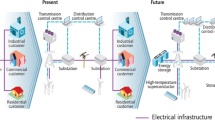Positions of interconnected switching devices determine the topological interlocks of switching operations at substations. The paper reviews two approaches for implementing programmable topological interlocks: offline and online. The paper highlights the disadvantages of offline and flexibility of online solutions. Anew object-topology approach to modeling of electrical networks is described. It allows applying the standard rules of topological interlocking automatically, both offline and online. An example of such automation is provided.
Similar content being viewed by others
Change history
04 June 2019
(1) The information about the article source should read: “Translated from <Emphasis Type="BoldItalic">Élektricheskie Stantsii</Emphasis>, No. 7, July 2018, pp. 29 – 37.”
References
RD 34.35.512. Instructions for Operating Real-Time Safety Interlocks in High-Voltage Electrical Switchgear [in Russian], approved by the USSR Ministry of Energy on October 05, 1979.
Operational Interlocking Organization Procedure at New Generation Substations [in Russian], approved by the Limited Liability Federal Grid Company of Unified Energy System (FGC UES, LLC) on May 05, 2010, No. 236 r. 3. State Standard GOST R 55608–2013. Unified power system and isolated power systems. Operational dispatch management. Switching at electrical installations. General requirements [in Russian], Moscow (2014).
SO 153-34.20.505–2003. Instructions for Switching at Electrical Installations [in Russian], NTs ÉNAS Publishing, Moscow (2004).
Rules on Labor Safety when Operating Electrical Installations (POTEU) [in Russian], approved by order No. 328n of the Ministry of Labor and Social Protection of the Russian Federation dated July 24, 2013; effective date: August 04, 2014.
E. Humby, Programs from Decision Tables [Russian translation], Mir, Moscow (1976).
A. V. Trofimov, A. M. Polyakov, G. A. Abdukhalilov, and R. A. Gorbunov, “Generating operational interlocking algorithms based on the information models of single-line diagrams of electrical installations,” Élektr. Stantsii, No. 7(1008), 2 – 5 (2015).
G. A. Abdukhalilov, Development of the Computer-Aided Procedure for Designing an Operational Interlocking of Digital Substations. Candidate’s Thesis [in Russian], MÉI, Moscow (2017).
V. I. Levin and B. V. Biryukov, “Another look at the history of discovering logical modeling of the technical devices,” Vestn. Mosk. Univ. Ser. 7. Filos., No. 1, 37 – 52 (2009).
V. A. Rosenberg, “Interlocking problem and contact groups transformation,” Avtomat. Telemekh., No. 1, 47 – 54 (1940).
B. I. Aranovich, Matrix Methods of Analysis and Synthesis of Contact-Relay Circuits. Candidate’s Thesis [in Russian], LÉTI, Leningrad (1947).
B. I. Aranovich, “Utilization of matrix methods in the aspects of structural analysis of contact-relay circuits,” Avtomat. Telemekh., 10(6), 437 – 451 (1949).
A. G. Lunts, “Application of matrix Boolean algebra to analysis and synthesis of contact-relay circuits,” Dokl. AN SSSR, 70(3), 421 – 423 (1950).
A. G. Lunts, “Synthesis and analysis of contact-relay circuits by means of characteristic functions,” Dokl. AN SSSR, 75(2), 201 – 204 (1950).
A. G. Lunts, “Algebraic methods of analysis and synthesis of contact circuits,” Izv. AN SSSR. Ser. Matem., 16(5), 405 – 426 (1952).
Yu. Ya. Kupershmidt, Yu. Ya. Lyubarskii, and V. G. Ornov, “Principles of developing a universal programmable switching training simulator,” Élektr. Stantsii, No. 11, 48 – 52 (1982).
I. A. Golovinskii, “Object-oriented approach to developing programs for analyzing switching diagrams of electrical networks,” Izv. RAN. Énerget., No. 2, 46 – 56 (2001).
I. A. Golovinskii, “Methods of analyzing topology of switching diagrams of electrical networks,” Élektrichestvo, No. 3, 10 – 18 (2005).
I. A. Golovinskii, “Logic and topology of switchover interlocks in electrical networks,” Int. J. Appl. Eng. Res., 11(3), 2007 – 2015 (2016), http://www.ripublication.com/ijaer16/ijaerv11n3_69.pdf.
Platform for solving power engineering problems KOTMI-14, DECIMA, http://www.decima.ru/upload/iblock/a4f/kotmi_14.pdf.
I. A. Golovinskii, “Topological object-association model for simulating electrical networks,” Int. J. Appl. Eng. Res., 11(12), 7857 – 7867 (2016), http://www.ripublication.com/ijaer16/ijaerv11n12_44.pdf.
IEC 61970-301. Energy management system application program interface (EMS-API), Part 301. Common information model (CIM) base.
Certificate of State Registration of Computer Software No. 2011613357, A. V. Tumakov, I. A. Golovinskii, M. I. Londer, and M. Yu. Dyachenko, Universal topological processor for electrical network intellectual management systems (UNITOP) [in Russian], registration date April 29, 2011.
A. A. Usitvina, Study of the Operational Safety Interlocking Systems at Energy Facilities with Voltage Exceeding 1 kV to Improve Power Safety and Efficiency. Candidate’s Thesis [in Russian], MÉI, Moscow (2014).
Author information
Authors and Affiliations
Corresponding author
Additional information
Translated from Gidrotekhnicheskoe Stroitel’svo, No. 7, July 2018, pp. 29 – 37.
Rights and permissions
About this article
Cite this article
Golovinskii, I.A., D’yachenko, M.Y., Londer, M.I. et al. Topological Interlocking of Operational Switching. Power Technol Eng 52, 605–613 (2019). https://doi.org/10.1007/s10749-019-01000-4
Published:
Issue Date:
DOI: https://doi.org/10.1007/s10749-019-01000-4




